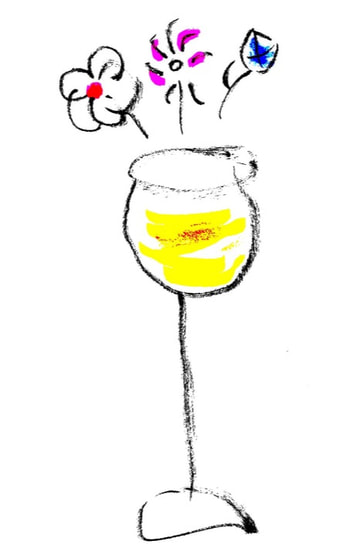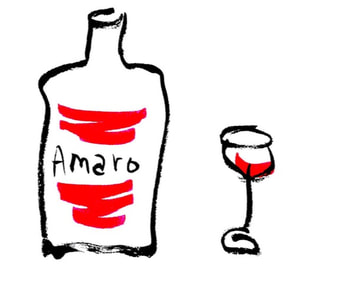 Bitterness plays a nice counterpart to balance out the aroma of flowers. Bitterness plays a nice counterpart to balance out the aroma of flowers. Once in awhile, you run across a white wine with a surprising mouthfeel or flavor, something that takes you aback and causes you to pay attention. Wines with phenolic bitterness may be among them. Certain grape varieties are known for producing wines that finish with a subtle and pleasant bitterness reminiscent of the sensation you get after eating a young almond or a grapefruit pith. This bitter aspect refreshes and dries out your mouth in preparation for the next drink. Phenolic bitterness causes polarities among drinkers as most people either love it or hate it. A difference of opinion over phenolic bitterness can occur between happily married couples who have developed a habit of sharing a bottle. Peter and I typically open a bottle with dinner, and the talk sometimes turns to a discussion of the wine that has been poured. I might ask, “What do you think of this Cabernet Franc?” To which he might respond, “Give me a minute,” and take an assessing drink. His answer: “There’s just not much there for me. It just doesn’t do it for me.” It’s a real head-scratcher when your partner does not share your zest for something you find completely scrumptious. For example, this very morning I got around to tasting a white plum that I had picked up at the farmers market on Sunday. It was so delicious that I felt I had to share it with Peter as part of our marital contract. I cut off a generous portion of the plum with my Japanese pairing knife and offered it to him as though I was the Eve to his Adam. Peter took a bite. To my surprise, his face took on a pained expression and he said, “It’s too sour!” To which I responded, “The tartness is the best part!” I understand intellectually that we are each entitled to our own opinion of what we like and don’t like, so I refrained from explaining that the tartness of the plum was balanced by the fruit’s sweetness and flavor elements. I took back from Peter what was left and consumed the balance of the plums, guilt-free.  Italians are known for enjoying food and beverages with pleasantly bitter flavors. Italians are known for enjoying food and beverages with pleasantly bitter flavors. Italians are known for enjoying food and beverages with pleasantly bitter flavors. Think about radicchio, Tuscan kale, dandelion greens, Amaro, Negroni, and Fernet Branca. Bitterness is also an essential element in Indian cuisine. Chefs build recipes with ingredients like bitter gourd, neem leaves, and fenugreek seeds and leaves, to mention a few. Meanwhile, food writers and scientists alert us that bitterness is becoming less prominent in American food and drink, leading to a loss of dietary diversity and complexity. The long and short of it is, if you enjoy food and beverages that offer the interest of savory or bitter characteristics rather than strictly fruity and sweet, wines with phenolic bitterness may be your cup of tea. Just maybe not your drinking partner’s. Right now as we speak, I am enjoying a 2019 Maidenstoen Grüner Veltliner from Edna Valley, located in San Luis Obispo County, California. Not only am I enjoying the pleasingly bitter finish but also the wine’s rich, generous body. Grüner can also be made in a leaner, crisper style, but this maker chose a more opulent approach. Pale lemon in color, it has a somewhat cloudy or hazy appearance, alerting me that this wine was possibly not fined or filtered. While I admire the glorious beauty of a crystal clear wine or beer, this dirtier style often includes more than the usual helping of flavor compounds that might otherwise have been stripped away. Fining and filtering involves removing fine particles before bottling; it also stabilizes the beverage. The Grüner in front of me has a medium-intensity nose of peaches, lemon drops, lilies, banana, lychee, butter, smoky yellow cheese, almonds, vanilla, white pepper, and a surprisingly fresh and wonderful hint of raw peas soaking in water. It is a dry wine, and I am guessing that the alcohol is higher than its Austrian counterparts because we are talking about grapes that were grown under the warm California sun. Grüner originated in Austria, probably in Niederösterreich (lower Austria), and it is the country’s signature white wine grape. Looking at the label of this California-grown and produced wine, we are at fourteen percent alcohol by volume. Edna Valley has one of the longest growing seasons in California. Warm weather and longer hang time allow the grape to fully ripen in the vineyard and gain in sugar content, driving up the alcohol level. If you love the tannins in red wine, you may be intrigued to explore white wines with this type of texture. The majority of Austria’s Grüners fall somewhere between eleven point five to thirteen percent ABV, largely due to the country’s cool continental climate. Grapes grown in cool climates tend to have lower alcohol levels and higher acidity than those grown in warm areas. However, you can expect a Grüner to have a high level of acidity regardless of where it is grown and the same is true with the Chenin Blanc grape. Some varietals retain their hallmark characteristics regardless of where they are grown. In our Edna Valley tasting, the flavors of this Grüner glide along on a carriage of high tangy acidity, and it is no surprise. The lavish body and gracefully lingering bitter resolution have me thirsting for the next sip. My assessment: I am going to quickly pause this conversation to re-order this wine for my next delivery. Okay . . . sadly this wine is sold out, according to the online merchant, so it looks like I am not the only one looking to repeat the experience. If you love the tannins in red wine, you may be intrigued to explore white wines with this type of texture. Wines with phenolic bitterness lend themselves to astringency on the palate, similar to a red wine of somewhat low to moderate tannins. Notice that several varieties on the list are aromatic wines with conspicuous floral qualities on the nose. The bitterness plays a nice counterpoint to balance out the aroma of flowers. Using any white grape variety, a winemaker can coax a sensation or a mouthfeel that differs from most other whites. In this case, the winemaker would have several techniques at her disposal. One approach involves keeping the juice in contact with the skins. Normally, the juice from white wine is separated from the skins and other matter upon arriving at the winery to keep the taste pure and to avoid oxidation. In some cases, however, the winemaker is looking to achieve pronounced flavor intensity and texture from the grapes. Skin contact facilitates the extraction of phenolic compounds into the juice. When the skins, seeds and other grape materials are not separated from the juice until after fermentation, the white wine is being vinified just like red wine. Such wines are commonly referred to as “orange wines” or “skin-contact” whites. Not all orange wines are the color orange, but they are certainly darker than traditional pale whites. The deeper color is leached from the grape skins, seeds and perhaps the stems. Oxidation also plays an important role in color, and the orange wine process invites oxygen to make an appearance during skin contact, thereby darkening the wine.  Bitterness is becoming less prominent in American food and drink, leading to a loss of dietary diversity and complexity. Bitterness is becoming less prominent in American food and drink, leading to a loss of dietary diversity and complexity. Take your time exploring orange wines, which are often produced without additives in what makers describe as a “natural” style. I have found that orange wines vary considerably in terms of flavor and quality, with some being undrinkable and others, heavenly. Some producers in Spain, California, Portugal and other locations include partial skin contact to develop texture and complexity in their wines. They ferment the wine with its skins for a short time or as a small part of a blend with conventionally made whites. White wines made with what amounts to a cameo appearance with the skins are not considered orange wines. Yet another technique for increasing mouthfeel: leaving the wine to rest as it evolves in the barrel or tank. Most wine producers rack their wines (move them from one vessel to another) several times after fermentation, leaving behind the particles at the bottom of the vessel to clarify and help stabilize the wine before bottling. Many orange wine producers subscribe to a more hands-off approach. It is their philosophy to let the wine “make itself” with as little intervention as possible, so they only rack just prior to bottling. (Non-orange wine producers can also choose to minimize racking to give the wine more personality.) Some producers ferment or age their orange wines in amphoras (clay containers) to further coax earthy, funky flavors from the grapes. While the use of clay in winemaking may seem cutting edge, it is actually a practice that goes back to about six-thousand years ago, where it originated in what is now known as the country of Georgia. Other unusual encounters with whites may include techniques that many attribute to Burgundian winemakers to enhance the wine’s mouthfeel and flavor, often using the Chardonnay grape. These include barrel fermentation and/or aging, malolactic fermentation (sour malic acid is converted to milky lactic acids), and wine aged sur lie (kept in contact with spent yeast cells). Chardonnay is often manipulated into textured wines but is not regarded as having phenolic bitterness. Incidentally, if you are wondering whether white wines contain tannins, they do, but at very low concentrations, so tannins are not addressed when tasting white wine. While Peter and I may have disagreed on the tastiness of the white plum, we do agree that Grüner Veltliner is the cat’s meow. For this reason, and others beyond his good looks, he retains his position as my key drinking partner, which is also in accordance with our marital contract. By the way, the list below is somewhat controversial among wine professionals, as not all agree upon the varieties that display phenolic bitterness. This list is more wide-ranging than many, giving us more examples to explore. Many of these varieties are ideal candidates for producing unusual textures at the very least. You might have fun going through the list to decide for yourself whether each varietal lives up to its reputation for phenolic bitterness. Bear in mind that you should try several examples of each variety because sometimes winemakers choose to mask the grape’s natural phenolic compounds during the winemaking process. Varieties with Potential Phenolic Bitterness Albana Albariño Assyrtiko Chenin Blanc (Loire) Gewürztraminer Gros Manseng Grüner Veltliner Kisi Melon de Bourgogne (Muscadet) Muscat Blanc/Moscato Pinot Blanc Pinot Grigio/Pinot Gris Riesling Robola Torrontés Traminette Trebbiano Spoletino Vermentino/Rolle Viognier This is one in a series of Grape Detective blogs featuring the attributes of wine and how your love for a specific wine grape may lead you to discover new grapes with similar characteristics. The focus of the list is grape variety and does not include blends, wine regions, or styles.
0 Comments
|
AuthorLyne Noella Archives
October 2022
Categories
All
|


 RSS Feed
RSS Feed
